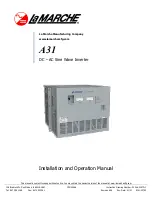
15.5 Inverter/Converter Cooling Design
1
5
-23
15.5 Inverter/Converter Cooling Design
If the Inverter/Converter is built into the panel, be sure to mount it vertically for effective cooling, and make
sure there is sufficient space to both the sides, and top and bottom, in consideration of maintenance and ventila-
tion, as shown in Fig. 2.9 and Fig. 2.10. (Refer to
2.3 CLEARANCES
for details.) There are two Inverter/Con-
verter models: External heatsink cooling models for the fully-enclosed control board mounting, and models
mounted inside the panel, which house the whole unit in the control panel. The external heatsink cooling model
cools the majority of generated loss from the unit using external air directly, so the generated loss in the control
panel is reduced.
The maximum operating temperature of the Inverter/Converter is 55
_
C. Design the cooling system so that the
average temperature rise within the control panel is 10 K (10
°
C (50
°
F)) max., taking the maximum control pan-
el ambient temperature to be 40
°
C (103
°
F). Consequently, heat caused by the generated loss of the Inverter must
be discharged using forced air currents and a heat exchanger. For the calorific value and cooling air speed of
each Inverter/converter by capacity, refer to
14.1.5 Calorific Value and Cooling Air Speed
.
15.5.1 Temperature Rise within the Control Panel
Taking the calorific value within the panel
P
(W), rate of heat conduction of the metal plate
k
(W/m
2
⋅
°
C),
and control panel surface area in contact directly with the external air
A
(m
2
), temperature rise within the
control panel
∆
T
(K) can be expressed using the following formula.
∆
T
=
P
k
×
A
(K)
The value of
k
changes according to the conditions as shown below.
D
With no internal circulation fan: 4 (W/m
2
⋅
°
C)
D
With internal circulation fan: 6 (W/m
2
⋅
°
C)
D
Cooling air duct with forced air current (with internal circulation fan): 9 (W/m
2
⋅
°
C)
The internal temperature rise
∆
T
(K) when using a heat exchanger can be expressed using the following
formula.
∆
T
=
P
k
×
(
A
−
B
)
+
qh
qh
:
Heat exchanger cooling ability (W/
°
C)
B
:
Heat exchanger surface area (m
2
)
AIR
Air
duct
Fig 1
5
.
27
Configuration of Control Panel with Air Duct
15
Summary of Contents for CIMR-M5 Series
Page 12: ...Notes for Motor xi...











































